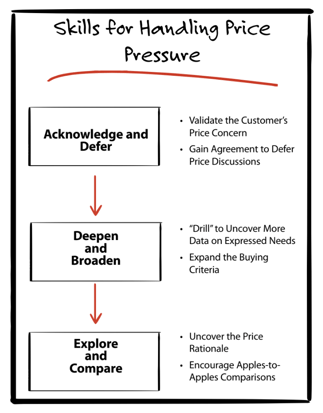You spent hours doing prep work, researching your potential customer, and getting ready for your meeting. You envision your perfect closing scenario and sit down for your meeting.
“Before you start, how much is it gonna cost me?”
Boom. There it is. Price pressure. Whatever number you say is likely going to be met with a solemn “mhmm” or a “that’s way too high, you’re going to have to do better than that.”
The average person hates these moments. Talking about price makes us feel uneasy and general friction related to money can be very uncomfortable. However, you, someone in pursuit of excellent negotiation skills, live for these moments.
The magic of handling price pressure and closing more business is to do it without giving unnecessary price concessions, discounts, or free giveaways.
Every time you frame a negotiation in terms of “how much you have to give up to make this deal,” you commoditize your product or service and drastically reduce your value as a business professional. A skilled negotiator looks at the alternatives they have at their disposal besides simply lowering prices.
You may not always be able to close important business without making some necessary price concessions, but you can use the following three skills throughout the sales process to minimize the number of costly concessions you must make and ultimately improve your deal profitability.

Price Pressure Skill #1: Acknowledge and Defer
When you acknowledge and defer, you’re able to keep the conversation productive and open up a longer time horizon in which to make your case for why your offering is worth its asking price. To execute this skill, you must:
- Validate the Customer’s Price Concern: The customer needs to feel like you’ve acknowledged the price issue and are committed to addressing. The key is to make them feel that their concern is important to you.
- Gain Agreement to Defer Price Discussions: Asking for permission to defer the discussion until later in the sales process helps gain a “buy-in” from the client and further time investment in the discussion.
Once you’ve acknowledged and deferred the price discussion, you can gain a deeper and broader understanding of the client’s buying criteria.
Price Pressure Skill #2: Deepen and Broaden
Now, it’s time to uncover the underlying reasons the customer is fixated on the price by deepening and broadening their buying criteria.
Deepen your understanding of the already stated customer needs by “drilling down” to uncover more relevant data.
Ask questions that reveal needs the customer is looking to solve with a solution such as yours and try to get them to quantify the problems or costs involved if they’re not solved.
Next, broaden the buying criteria by searching for additional needs you can satisfy. The goal is to turn price into one of many criteria instead of being the only focus of the discussion. Move the discussion towards a playing field where the many other aspects of working with you are able to shine. There are a handful of effective ways to broaden the buying criteria:
- Redefine the product to highlight the features that stand out from similar products on the market. Explain why it’s worth your customer’s hard-earned money with tangible evidence.
- Broaden the application to help your customer see it as more valuable than simply solving one problem.
- Move from short-term to long-term so that your customer can justify spending more money on it in the long term.
- Sell your company, not just your product. Often, the biggest difference between products in the market is the company that helps service and provides support for them.
Buying criteria may be objective, but the way people weigh them up is subjective. Be sure to broaden and deepen the discussion before moving onto the third and final step.
Price Pressure Skill #3: Explore and Compare
Once you’ve discussed the customer’s needs completely and expanded the buying criteria, it’s time to return to the previously tabled price objection. Now, it’s time to explore and compare.
The first step is to uncover the price rationale. Don’t simply make an assumption that the client wants a cheaper price because they think less expensive is better. For example, the underlying reason is that they want to look good in front of their boss. Equipped with that information, you can find a way to leverage your other negotiables to keep your price within your price range while also helping them appear positively to their boss.
Ask Open Questions to get the customer to express why they believe a price reduction is required. Listen carefully to the answers, and Test and Summarize. Try to uncover the “why” behind the “what” of the objection.
Next, encourage the making of “apples-to-apples” comparisons. Often, price pressure is the result of the client’s finding of similar options on the market. Making “apples-to-apples” comparisons is a constructive way to showcase how your option meets the criteria you’ve uncovered in the “deepen and broaden” phase.
Ultimately, if you can help the client see that alternative options might cost less up-front, they may actually deliver much less value than your product or service.
Maintaining tension during a negotiation as necessary in order to send two critical messages to your client:
- You’re committed to addressing their price issues.
- You have a deep commitment and belief in the value of your proposal.
Final Thoughts
Each price pressure situation is an opportunity to sharpen your sword in live combat. The more situations you encounter, the better of a negotiator you become.
By using the three price pressure skills above, you’ll not only be able to get more value from your negotiations, but also develop a more in-depth understanding of what the market values most in regards to your offering, and how to fine-tune your communication to close more sales.



